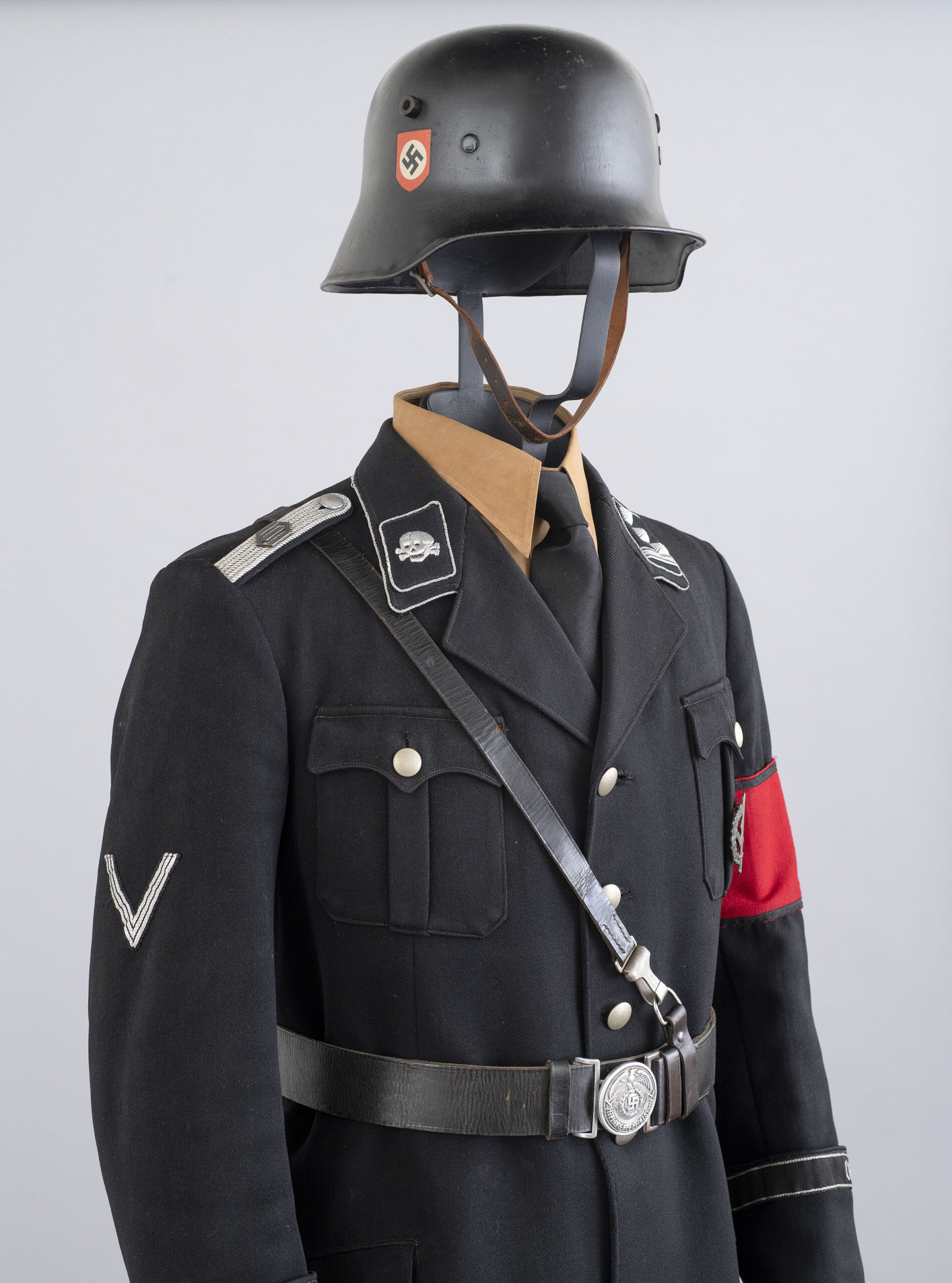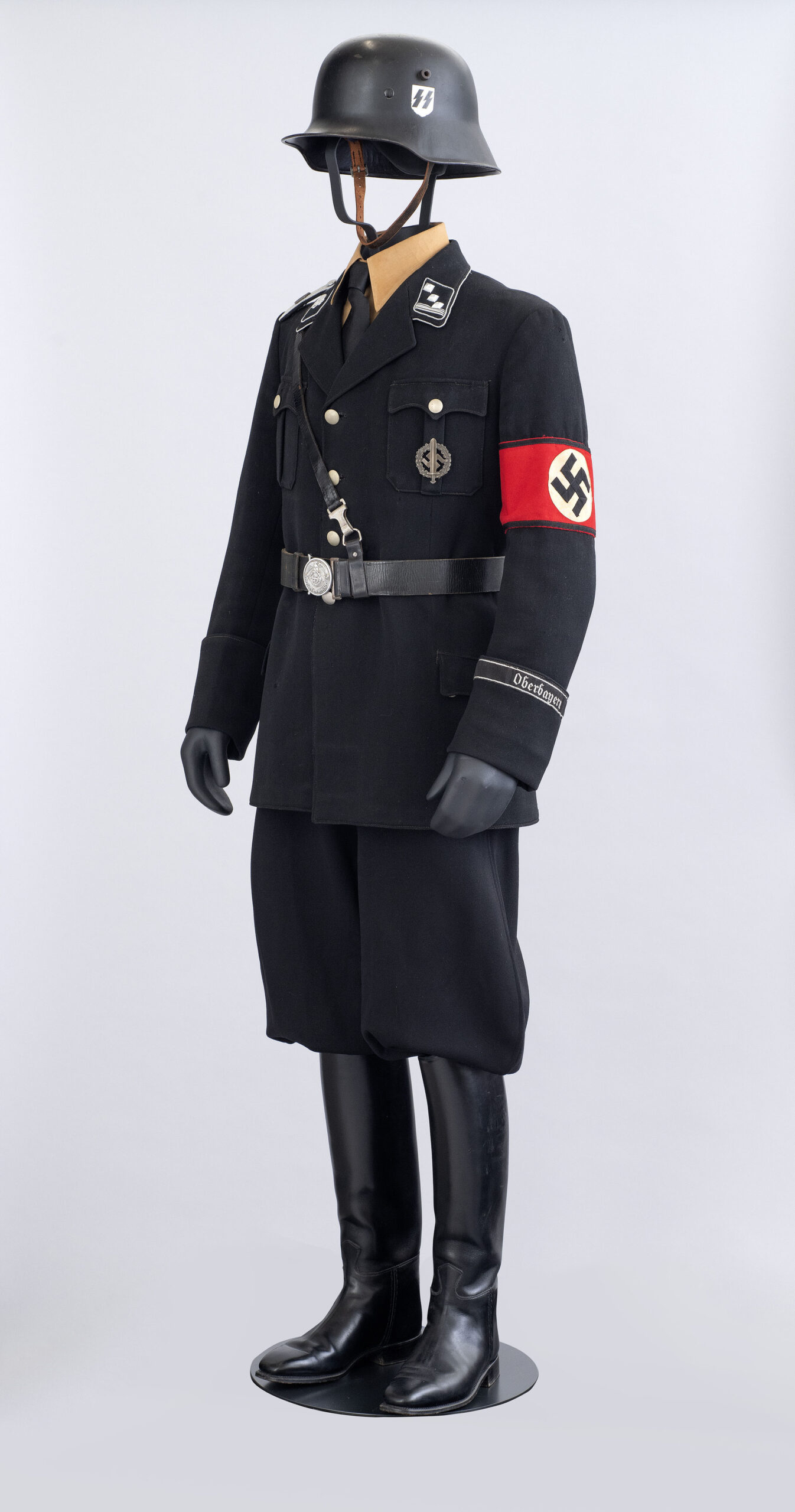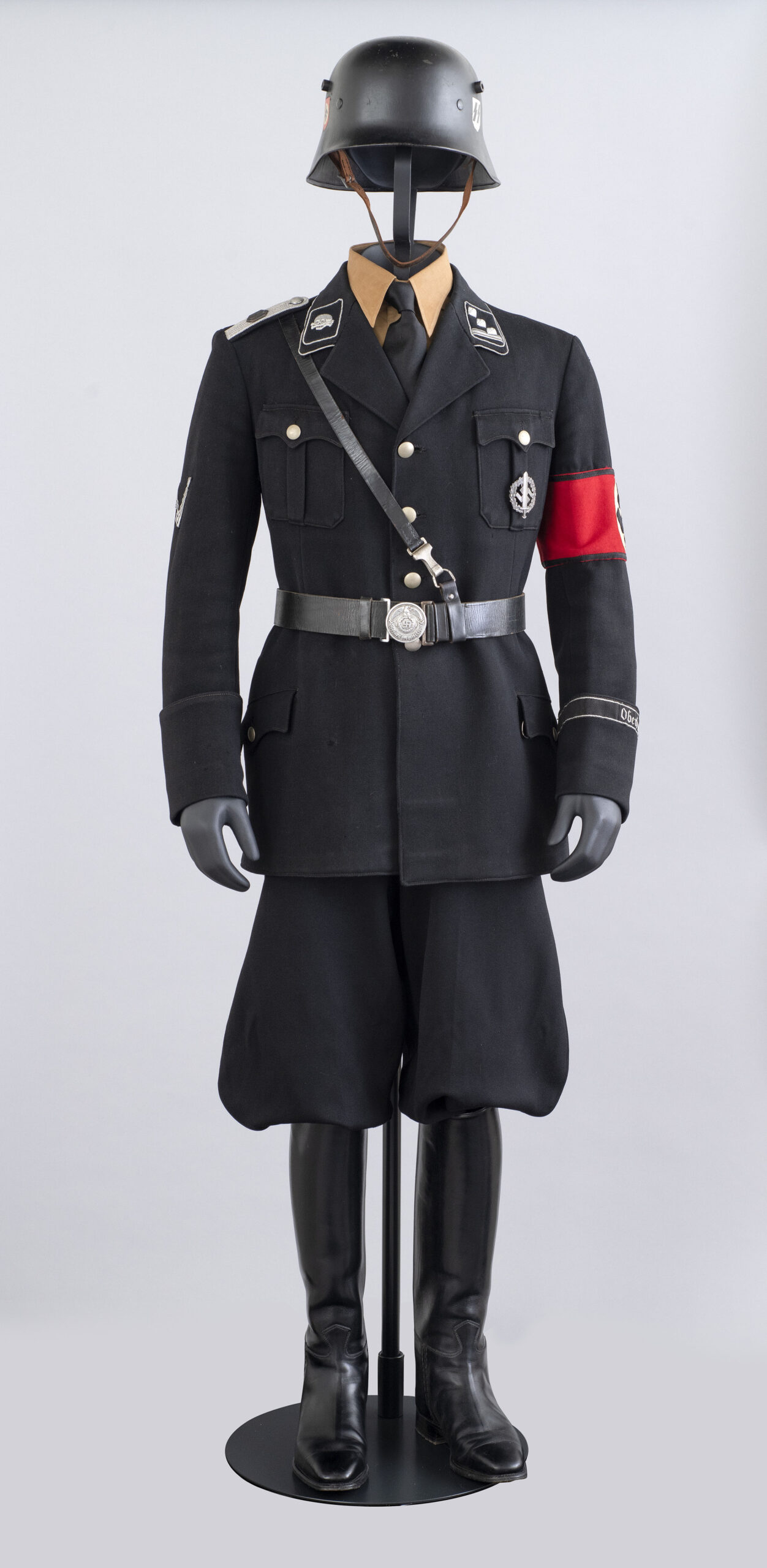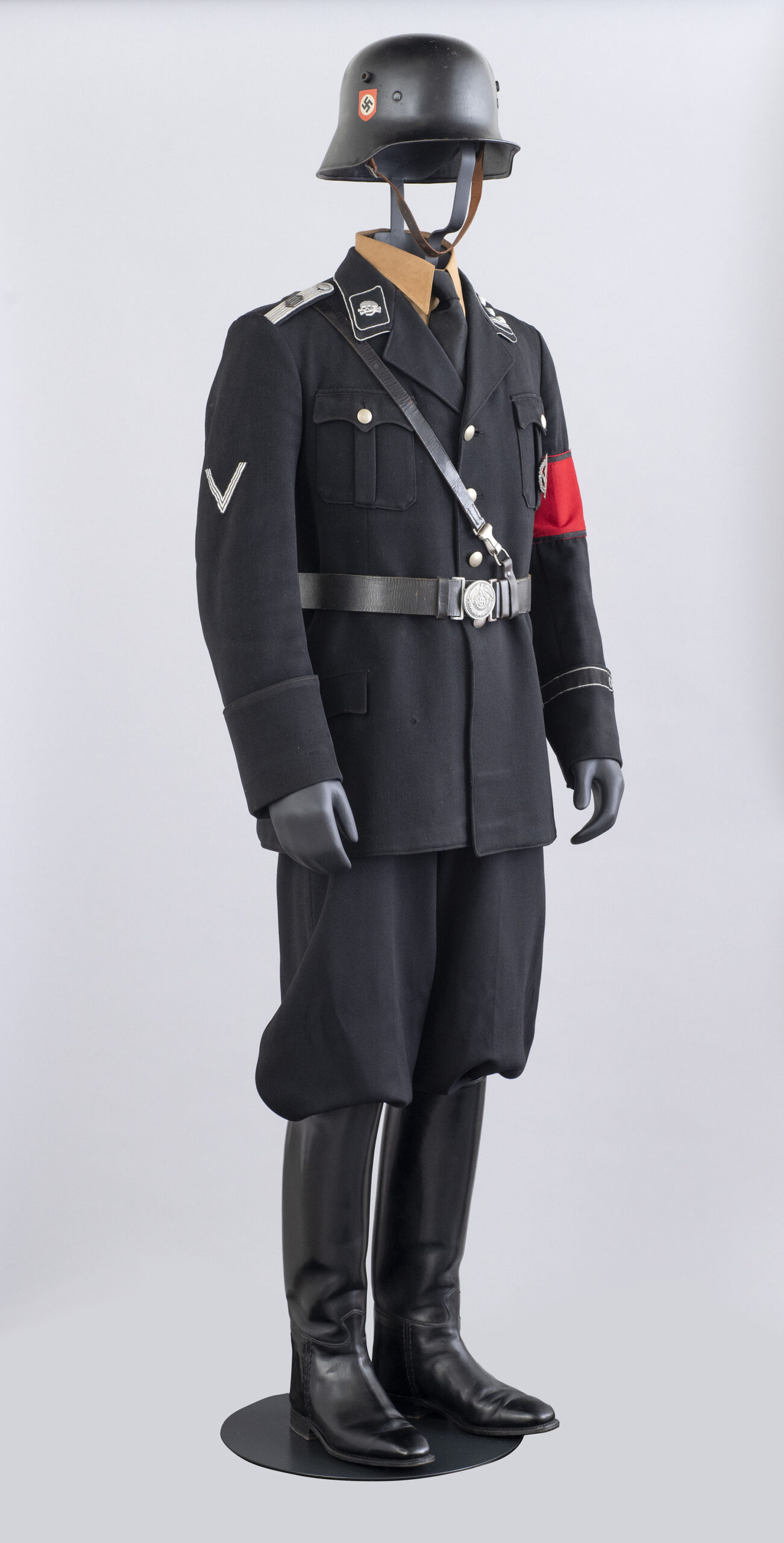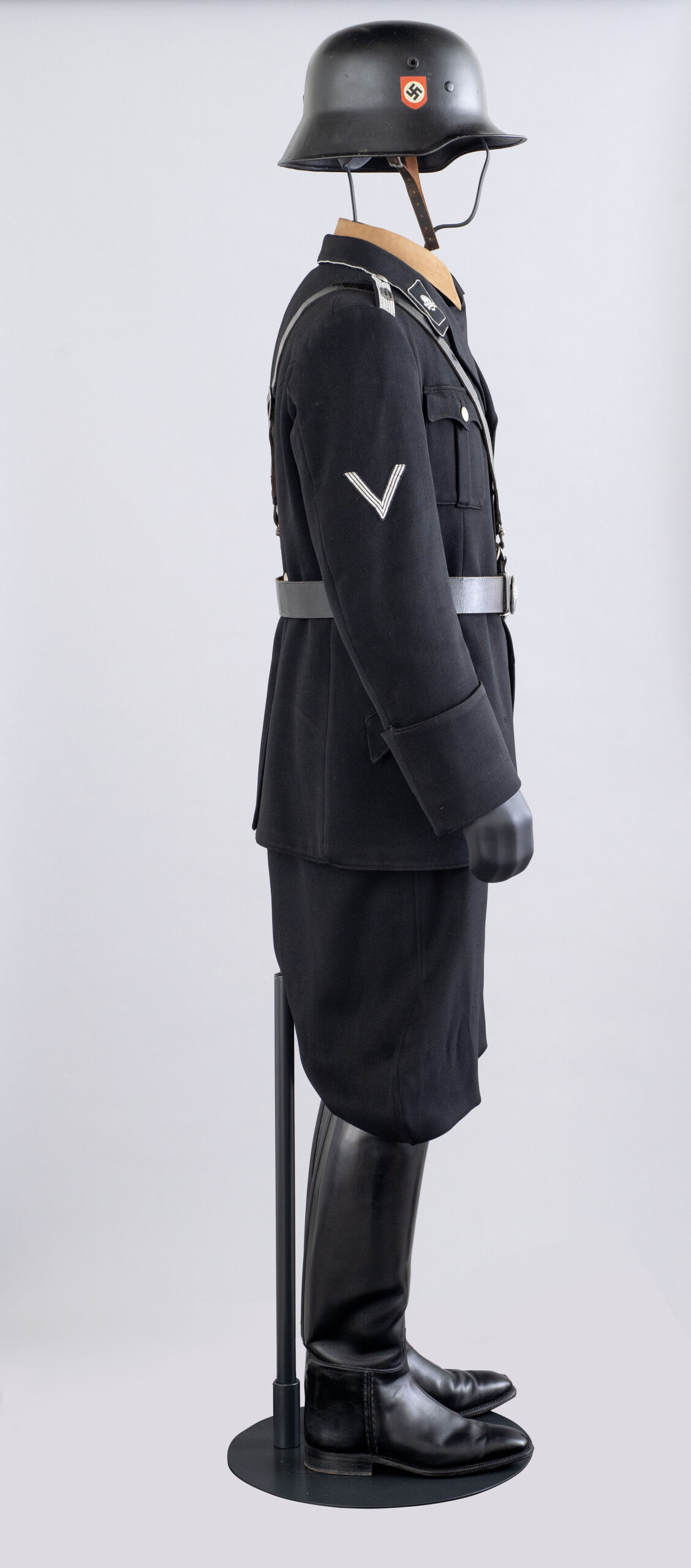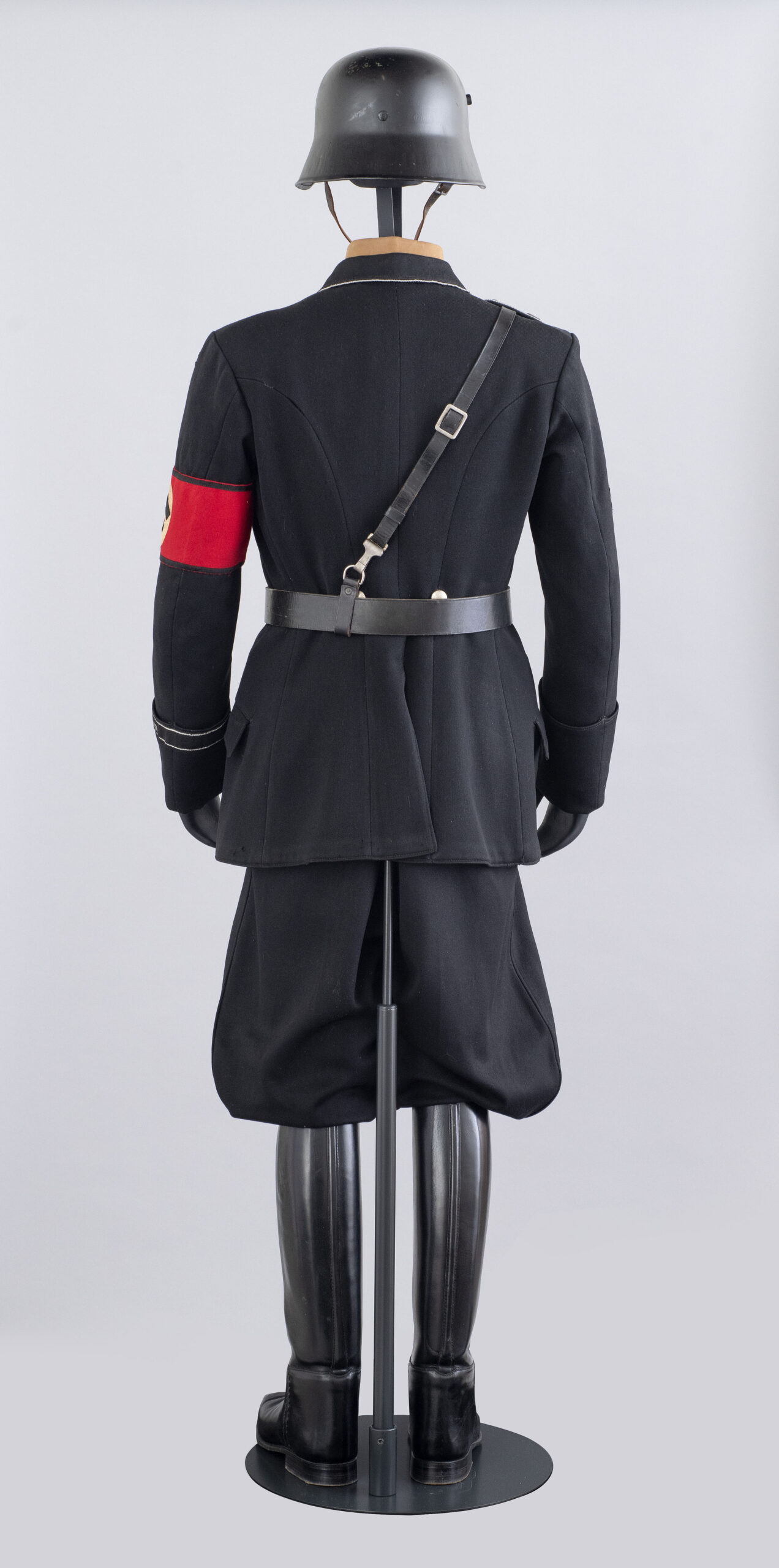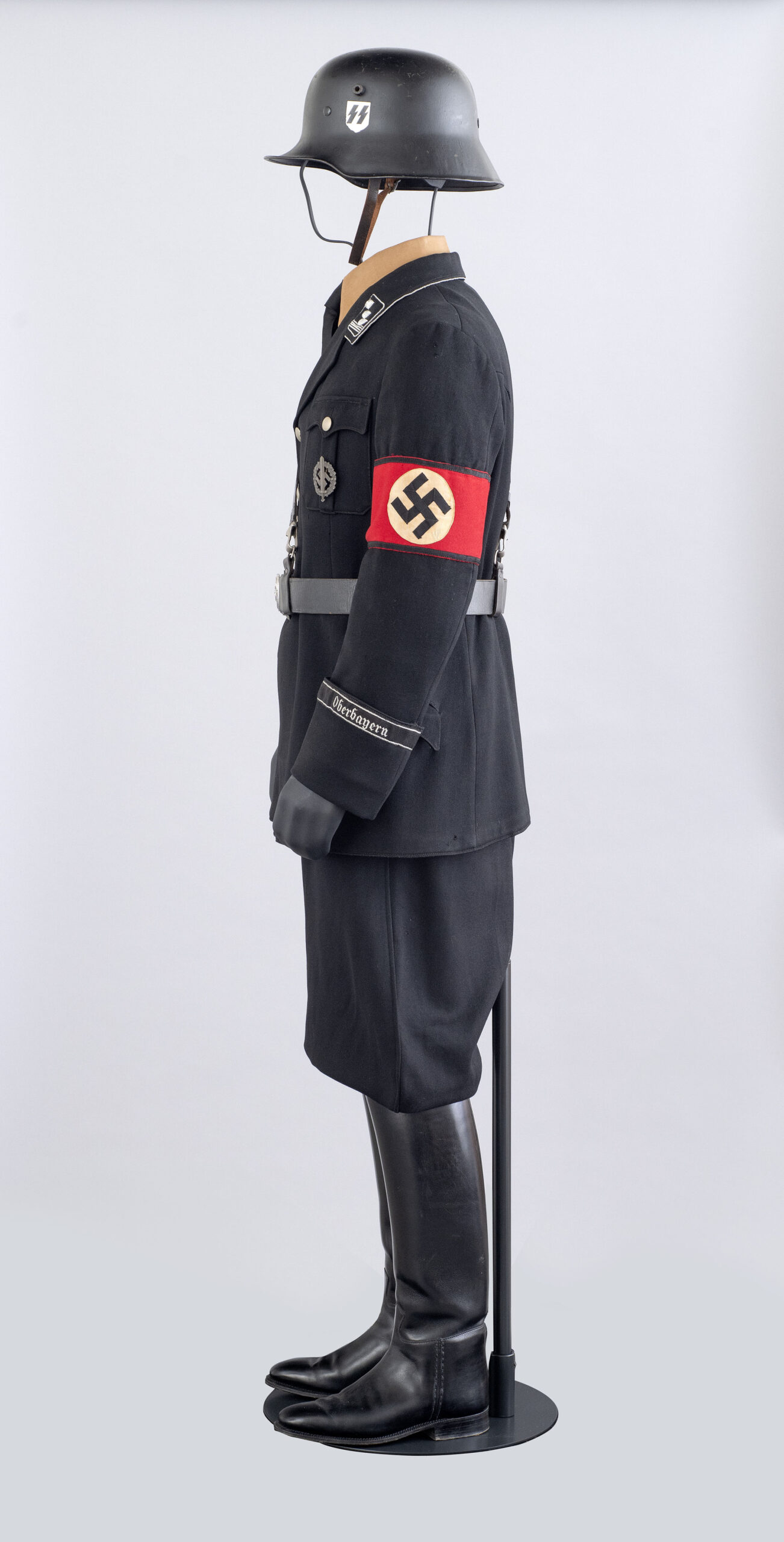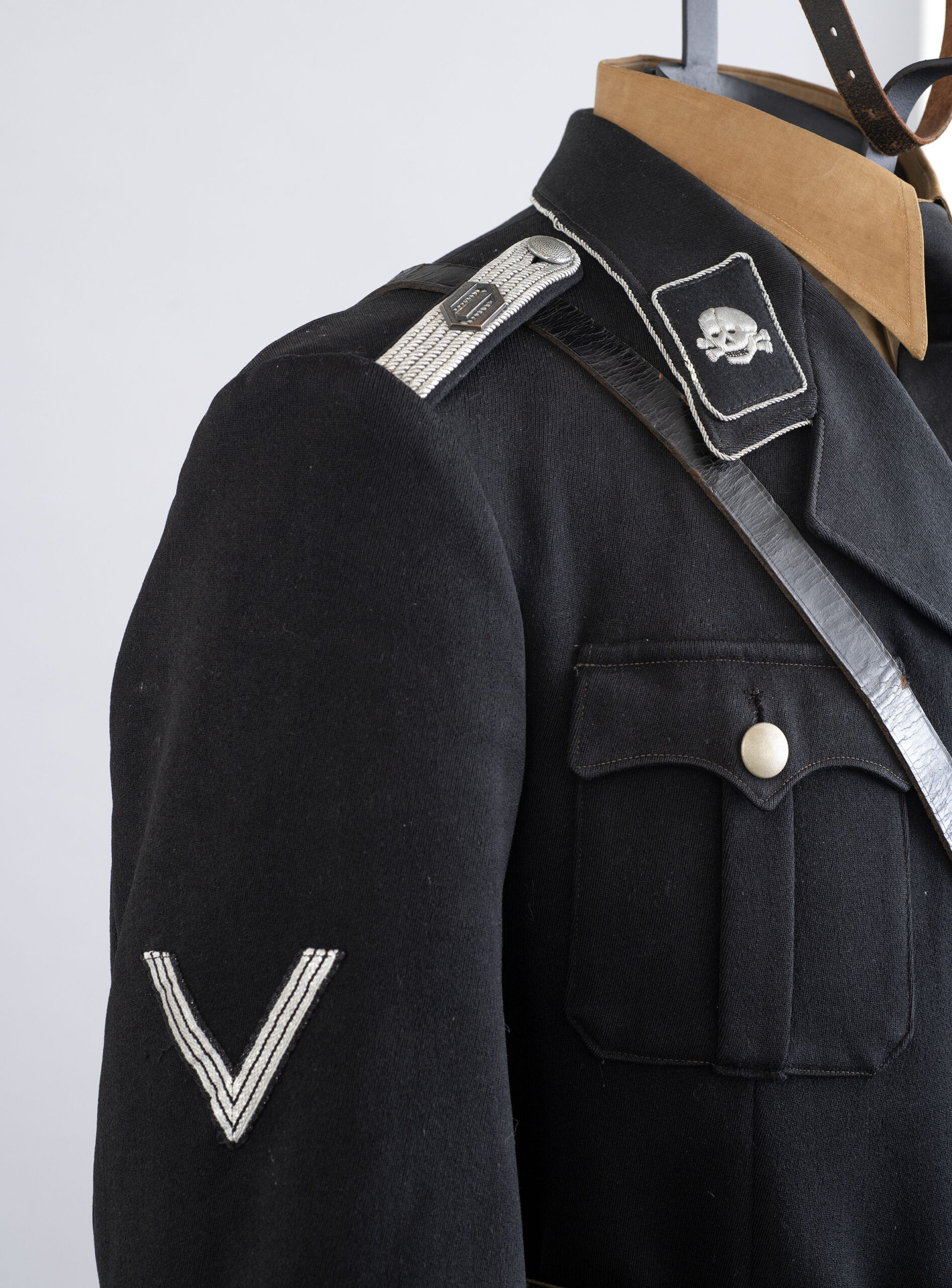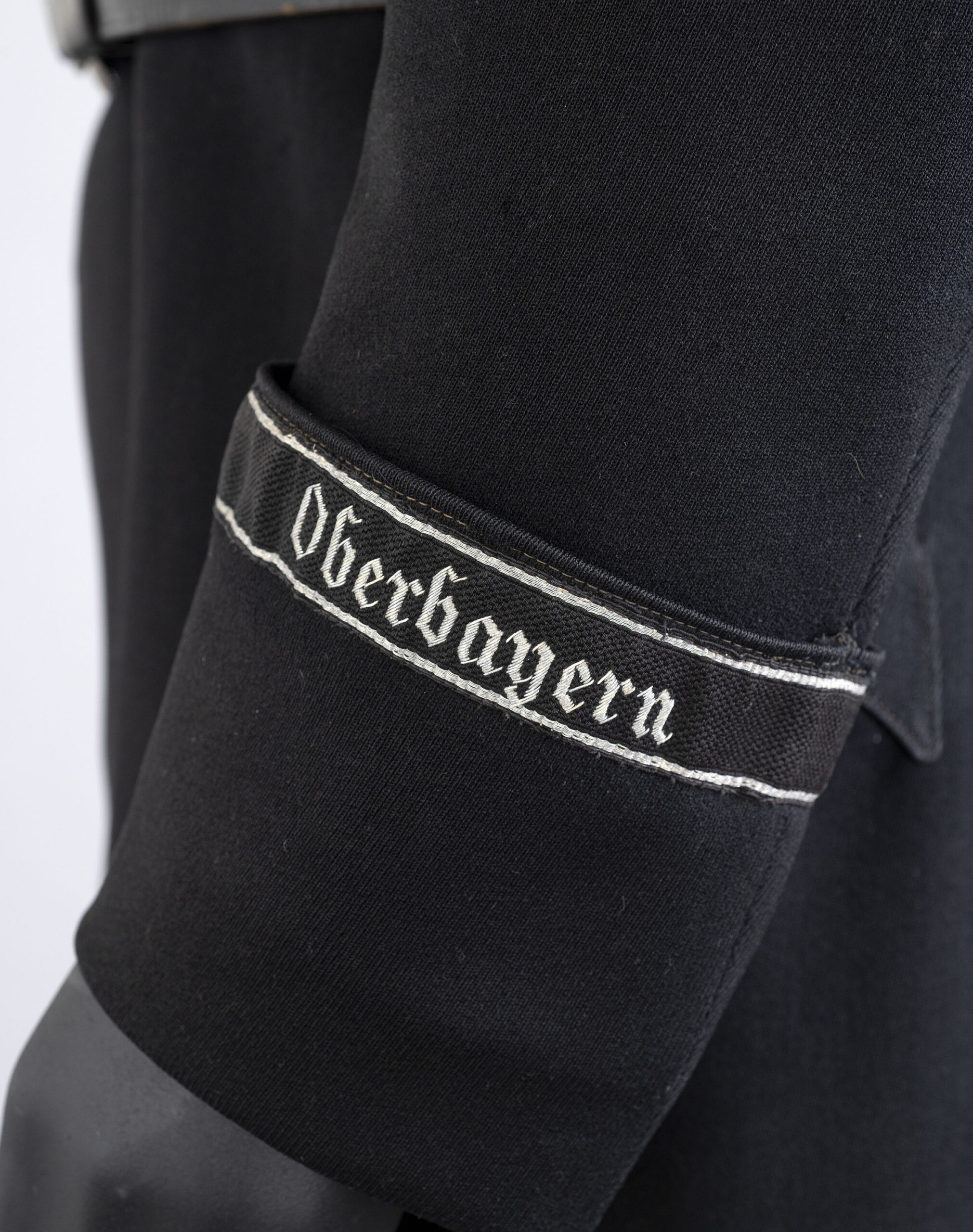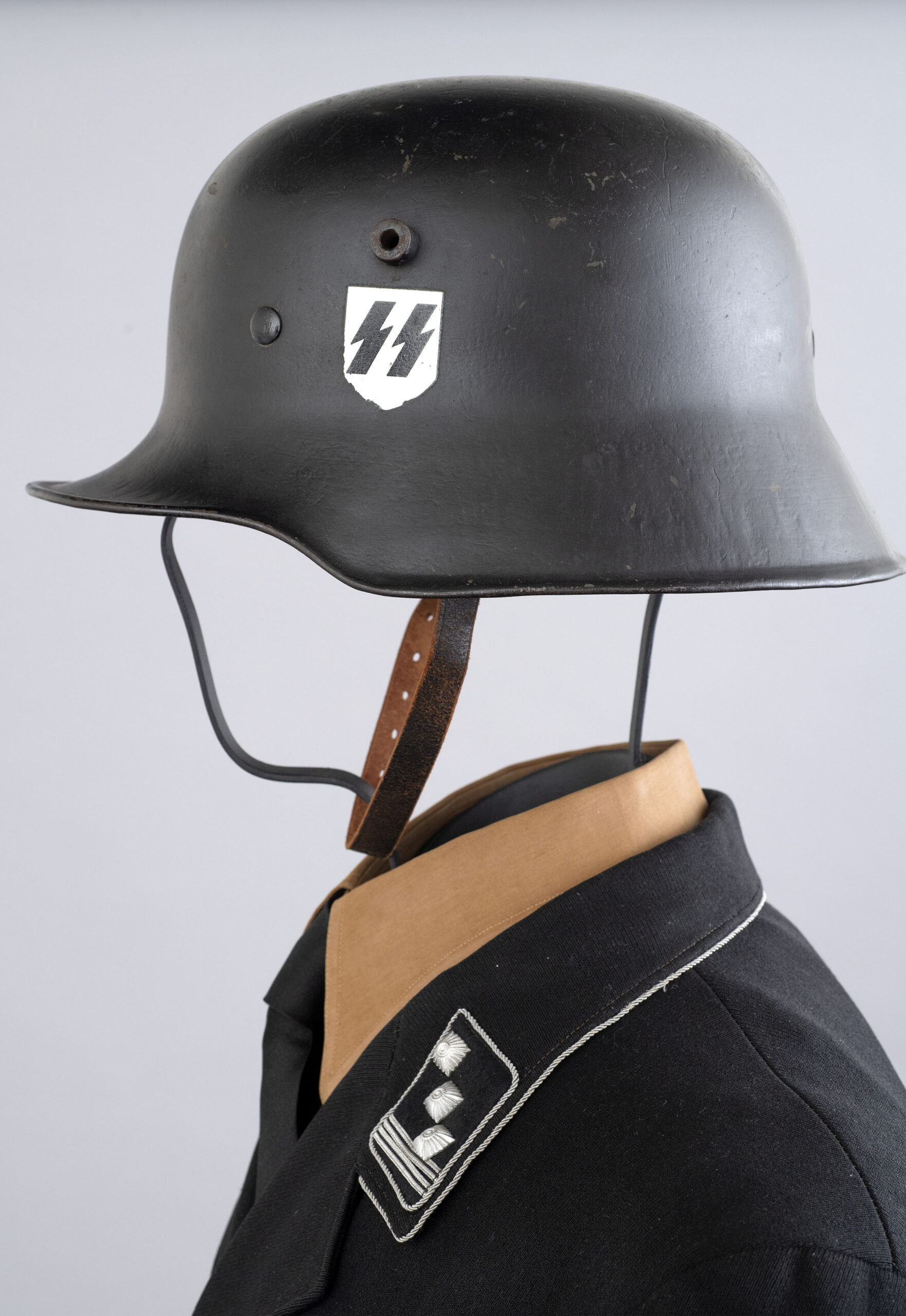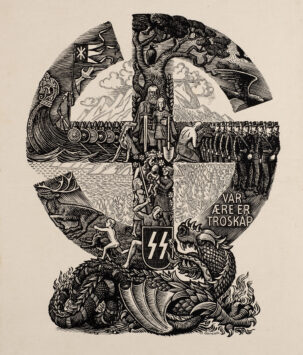SS-Totenkopfverbände Uniform
The SS-Totenkopfverbände (SS-TV) was a branch within the Schutzstaffel (SS) responsible for administering Nazi Germany’s concentration camps. Distinguished by the death’s head (Totenkopf) symbol adorning their right collar tab, the SS-TV were entrusted with dispensing justice to those considered enemies of the Reich. As guardians of the Volksgemeinschaft (People’s Community), they carried out this task, which was seen as a necessary evil, with grim determination, with this fearlessness reflected in their all-black uniforms. The SS-TV’s death’s head insignia similarly signified a willingness to sacrifice their lives for the cause, as well as their mastery over death as the Reich’s elite cadre of camp guards. The unmistakable aesthetic of the Totenkopfverbände, with their black uniforms and death’s head insignia, would come to be feared by their foes as they would be revered by their allies.
The SS-TV was divided into multiple regiments (standarte), each tied to the concentration camp they initially oversaw. This uniform belongs to the prestigious 1st SS-TV regiment “Oberbayern” (1. SS-Totenkopfstandarte “Oberbayern”), the original nucleus from which the entire SS-Totenkopfverbände was formed. The ‘O’ for “Oberbayern” adorning the tunic’s right shoulder board serves as the wearer’s regimental identification.
Headed by SS-Obergruppenführer Theodor Eicke, the “Oberbayern” regiment was formed as the guard detail of the now notorious Dachau concentration camp, located in Upper Bavaria and named after said region. Eicke officially codified and structured the highly efficient local camp system for its adoption nationwide, and as Germany’s concentration camp system grew, each would come to be modeled after the standard set at Dachau by the 1st “Oberbayern” regiment.
Interestingly, this SS-Hauptsturmführer tunic also boasts an honor chevron (Ehrenwinkel der Alten Kämpfer) on its left sleeve, signifying the wearer as an Alten Kämpfer (Old Fighter), a title bestowed to early members of the Nazi Party who had joined prior to their ascent to power in 1933. The uniform is paired with a double decal M18 helmet, an earlier model of the stahlhelm which was commonly employed by Nazi Germany’s internal security forces (such as the SS-TV), being surplus equipment from the First World War. The original owner of this uniform was undoubtably a deeply loyal apostle of the National Socialist cause, being an early proponent of the Nazi Party to also oversee its burgeoning concentration camp system, likely having had a direct influence on the Reich’s later genocidal machinations.
Given their original role as elite prison guards, members of the SS-TV were accustomed to security operations and would undergo military training as part of their continuous professionalization. As Germany drew closer to war, the SS-TV would come to be mobilized and deployed in active combat, primarily in counterterrorism and rear-area security duties. The “Oberbayern” regiment was deployed in Poland behind the Wehrmacht’s tenth army, rooting out subversion and pacifying resistance in occupied territories. By protecting supply lines and freeing up frontline troops from garrison duties, the SS-TV contributed greatly to the operational successes of the Wehrmacht. Within these functions the Totenkopf insignia and their reputation for ruthlessness acted as force multipliers, with civilians and partisans alike often avoiding direct clashes with SS-TV forces, further promoting regional stability within territories stationed by German forces as a result.
With the outbreak of the Second World War, parts of the “Oberbayern” regiment were reorganized as a frontline Waffen-SS division, and quickly earned a reputation for its fanaticism. Aside from accruing inflated casualty rates due to their reckless offensive maneuvers, the division engaged in numerous extrajudicial killings of captured Allied prisoners of war, particularly (colonial French) Arab troops who were considered racially inferior.
Free shipping on orders over $50!
- Satisfaction Guaranteed
- No Hassle Refunds
- Secure Payments
The SS-Totenkopfverbände (SS-TV) was a branch within the Schutzstaffel (SS) responsible for administering Nazi Germany’s concentration camps. Distinguished by the death’s head (Totenkopf) symbol adorning their right collar tab, the SS-TV were entrusted with dispensing justice to those considered enemies of the Reich. As guardians of the Volksgemeinschaft (People’s Community), they carried out this task, which was seen as a necessary evil, with grim determination, with this fearlessness reflected in their all-black uniforms. The SS-TV’s death’s head insignia similarly signified a willingness to sacrifice their lives for the cause, as well as their mastery over death as the Reich’s elite cadre of camp guards. The unmistakable aesthetic of the Totenkopfverbände, with their black uniforms and death’s head insignia, would come to be feared by their foes as they would be revered by their allies.
The SS-TV was divided into multiple regiments (standarte), each tied to the concentration camp they initially oversaw. This uniform belongs to the prestigious 1st SS-TV regiment “Oberbayern” (1. SS-Totenkopfstandarte “Oberbayern”), the original nucleus from which the entire SS-Totenkopfverbände was formed. The ‘O’ for “Oberbayern” adorning the tunic’s right shoulder board serves as the wearer’s regimental identification.
Headed by SS-Obergruppenführer Theodor Eicke, the “Oberbayern” regiment was formed as the guard detail of the now notorious Dachau concentration camp, located in Upper Bavaria and named after said region. Eicke officially codified and structured the highly efficient local camp system for its adoption nationwide, and as Germany’s concentration camp system grew, each would come to be modeled after the standard set at Dachau by the 1st “Oberbayern” regiment.
Interestingly, this SS-Hauptsturmführer tunic also boasts an honor chevron (Ehrenwinkel der Alten Kämpfer) on its left sleeve, signifying the wearer as an Alten Kämpfer (Old Fighter), a title bestowed to early members of the Nazi Party who had joined prior to their ascent to power in 1933. The uniform is paired with a double decal M18 helmet, an earlier model of the stahlhelm which was commonly employed by Nazi Germany’s internal security forces (such as the SS-TV), being surplus equipment from the First World War. The original owner of this uniform was undoubtably a deeply loyal apostle of the National Socialist cause, being an early proponent of the Nazi Party to also oversee its burgeoning concentration camp system, likely having had a direct influence on the Reich’s later genocidal machinations.
Given their original role as elite prison guards, members of the SS-TV were accustomed to security operations and would undergo military training as part of their continuous professionalization. As Germany drew closer to war, the SS-TV would come to be mobilized and deployed in active combat, primarily in counterterrorism and rear-area security duties. The “Oberbayern” regiment was deployed in Poland behind the Wehrmacht’s tenth army, rooting out subversion and pacifying resistance in occupied territories. By protecting supply lines and freeing up frontline troops from garrison duties, the SS-TV contributed greatly to the operational successes of the Wehrmacht. Within these functions the Totenkopf insignia and their reputation for ruthlessness acted as force multipliers, with civilians and partisans alike often avoiding direct clashes with SS-TV forces, further promoting regional stability within territories stationed by German forces as a result.
With the outbreak of the Second World War, parts of the “Oberbayern” regiment were reorganized as a frontline Waffen-SS division, and quickly earned a reputation for its fanaticism. Aside from accruing inflated casualty rates due to their reckless offensive maneuvers, the division engaged in numerous extrajudicial killings of captured Allied prisoners of war, particularly (colonial French) Arab troops who were considered racially inferior.
